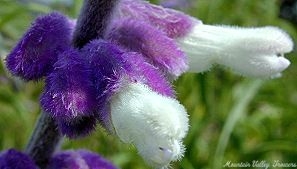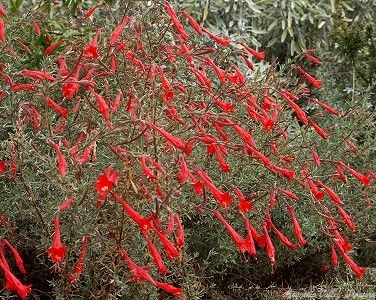Fall's Fabulous Follies!
I’m not sure what it is about most of us that makes us SO Utilitarian, but it seems like every year the theatrics surrounding which plants to choose for our gardens heightens to new levels. Our culture is full of phrases like more bang for your buck (which translates to: buy plants that bloom every day of the year) or the early bird catches the worm (if the plant doesn’t start blooming in spring and bloom till frost forget it) or two wrongs don’t make a right (if you chose a plant last year that only looked spectacular for two months don’t buy that one again).
I, too, have been guilty of excluding plants from my garden because their performance may be two blooms shy of the mark (that unknown quantity/quality we are sure is out there but can’t seem to define OR locate). I have described many plants as blooming all the time or, on the reverse side of the coin, as shutting down in the heat, a condition which obviously must be avoided at all costs. Right??
Several years ago I was interested in building a Pergola. I had seen one somewhere and loved the idea but wasn’t really sure what comprised such a structure. I mean, let’s face it, in California we have DECKS. The book I purchased to enlighten myself (I am, quite frankly, addicted to books) was called Pergolas, Arbors, Gazebos and Follies. I was pretty sure I understood Arbors and Gazebos but what a Folly was I had no idea. What I discovered was kind of hard for my utilitarian nature to understand. Basically, a folly is a joy that goes nowhere. For example, a pathway that leads to a dead end where maybe a secret statue is hidden. It’s a thing of beauty or humor that just is. Usually they are grand, always they are fun.
It wasn’t long before I realized that some of the plants I had been chastising were superb follies. Now I cherish those that will only grace us with their bounty for a short time in the fall or those that give us spring and fall bloom but prefer to remain mute in the blazing hot summer. There are even one or two we grow who never bloom here because our first frost comes too early but whose foliage adds wonder to our gardens. I say the more folly the better. Let the revelry begin.
MEXICAN BUSH SAGE

The most striking plant for fall has to be Mexican Bush Sage. This is a tall, stately plant with multitudes of long, velvety, purple and white flower spikes. A native to Mexico, it thrives equally well where temperatures remain above freezing and where temperatures reach into the teens. If the temperature threatens to dip below 15 degrees, a 6 inch layer of mulch or an upturned 15 gallon pot will help protect the crown. Here, even a brief dip to 5 degrees did not kill our plants. However, we did allow the spent canes to remain towering over the crowns which may have added a bit of protection. The first winter it is especially important to keep a close eye on the temperatures.
Although Mexican Bush Sage can be maintained in temperate climates as an evergreen, it is more beautiful when cut back to the ground in winter. The fresh growth easily reaches the desired height of 3-4 feet in time for its spectacular fall extravaganza.
Mexican Bush Sage comes in two flower colors. On both varieties the calyx, the little papery shell that holds the actual flower, is purple. On the regular variety the flower is white and on the other, All Purple Mexican Bush Sage, the inch long flower matches the calyx.
Both varieties are luxurious to view. The flower spike continues to get longer, eventually reaching two feet, as the flowers open progressing from bottom to top.One plant will spread out to about 4 feet in diameter as the crown grows larger each year. It is never necessary to dig it up and divide it. And except for the pruning of its dead flower canes in winter, it is maintenance free. Many people prefer the softness of the purple and white variety claiming that the all purple is too intense for many color schemes. And, while it is true it screams purple it is my choice for planting as a backdrop to our next winning fall follies, both Epilobiums California Fuchsia and Hummingbird Plant. All Purple Mexican Bush Sage and Mexican Bush Sage can be planted together and when they grow together it appears different flower spikes have formed on the same bush. Another folly!!
CALIFORNIA FUCHSIA and HUMMINGBIRD PLANT

California Fuchsia is a riot of lipstick orange, two inch long, tubular flowers. This planted together with Mexican Bush Sage is not only a visual paradise but is also a virtual airport for the equally riotous and colorful hummingbird. They soar and fight and hover, enjoying their fall folly and adding to ours. This gray, needlelike shrub reaches about two feet and flowing waves of flower stems add an additional foot or more to the plants height.
Hummingbird Plant has very similar flowers to California Fuchsia but its leaves are green instead of gray. They both attract hummingbirds and are important fall blooming plants for this reason.
When the plants have finished flowering, they benefit greatly from a severe pruning. Cut about two-thirds of the height off, leaving a mound of soft gray. When the weather warms it will quickly grow and provide attractive foliage through spring and summer. California Fuchsia and Hummingbird Plant, stay evergreen here, even at 15 degrees. Mexican Bush Sages have stems that are tall and stiffly erect while the Epilobiums are arching and full of motion making them not only good fall blooming companions, but good garden companions. For an outstanding trio add Pink Gaura. Pink Gaura is a treasure that blooms most of the year. By fall the wands are long and willowy adding another type of texture and visual interest to this combination.
LION’S TAIL
Both Mexican Sages make good cut flowers but, for that perfect autumn orange bouquet, nothing beats Lion’s Tail. It makes a good cut flower for the vase and an excellent dried flower for crafts. And, while All Purple Mexican Sage looks great planted with California Fuchsia, the regular Mexican Bush Sage is complimented more by Lion’s Tail, also sometimes called Lion’s ear.
Here in Zone 8, Lion’s Tail is a herbaceous shrub that grows to about three feet. It is hardy to at least 15 degrees. It can remain evergreen but, like Mexican Bush Sage, looks better when pruned back to the ground and allowed to grow fresh in the spring. It’s two inch long leaves are dark green and about 1/2 inch wide with a slightly toothed margin. It’s flowers are soft, fuzzy orange whorls that ascend in pom-pom like fashion up the stalk. Each pompom cradles multitudes of flowers rotating around the head. One pom-pom is followed by another and, if you want to dry the flower, it should be cut when one or two bottom pom-pom flowers are fully open and one or two of the upper ones are yet to unfurl.
Fall’s Follies also include Salvia elegans Pineapple Sage and Tangerine Scented Marigold. Fall’s Follies are carried on by the continuing performance, or a second show in fall in warmer climates, of Santa Barbara Daisy, Russian Sage, Maraschino Cherry Salvia and .Wild Watermelon Salvia
